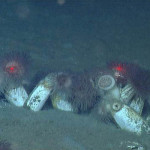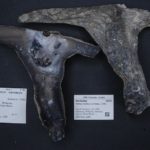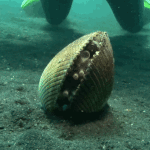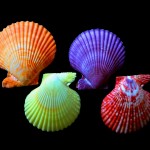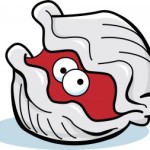A report from Dr. M while he is at sea in the northeast Pacific. You can also follow the expedition here.
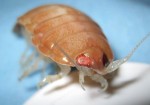
Saturday, we steamed to the south to visit Escanaba Trough at 3321 meters, our deepest dive of the expedition. The site is the sediment-filled, southernmost segment of Gorda Ridge, just slightly northward of the Mendocino Fracture Zone. The trough contained long dead volcanic structures that pierce the thick layer of sediment ooze.
We were here for a major clam dig and targeted Ectenagena extenta, a deep-sea bivalve with chemoautotrophic bacteria, for a population genetics study. E. extenta is a giant among deep-sea bivalves reaching over 30cm in length. In general, bivalves associated with vents and seeps are larger than those living in the background sediment that comprises the majority of the deep-sea. The typical deep-sea bivalves rarely reach more than the size of a dime. Of course, vent and seeps clams live in a smorgasbord of food, eating till they are content, and grow accordingly. Their abyssal brethren rarely see food. When they do, it is patchy in time and space and of appalling quality and quantity.
On the soft muddy bottom of the abyss, real estate of the hard variety is a rarity. The 15 centimeters of clamshell exposed above the sediment surface is prime reality. We located E. extenta by the collection of anemones, often more than dozen, perched on each shell. They are small-forested islands in a vast ocean of sediment. The other Dr. M continues his collection of seastars, many potentially new to science, others known but rarely observed. The advances to our knowledge of deep-sea systems expand every dive we make to the seafloor.
Unfortunately, poor weather returns like cheap Mexican food and dollar shots of tequila. We reevaluated our dive plan, the fourth time of this expedition, and decided to steam far south. We will loose diving on Sunday to make for Pioneer Seamount 270 nautical miles south of our current location but well outside the reach of heavy swell and whitecaps generated by the storm. A pod of 50-100 Pacific Whiteside Dolphins accompanied us for nearly half an hour before they grew weary of our 11-knot speed and swam swiftly ahead.
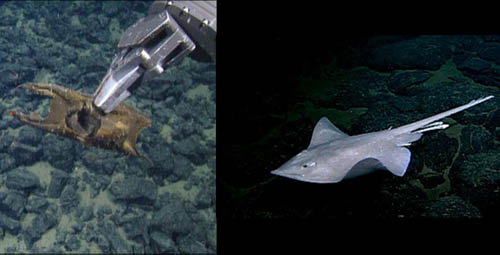 Bathyraja spinosissmia (on right). Photos courtesy of MBARI” width=”500″ height=”255″ />
Bathyraja spinosissmia (on right). Photos courtesy of MBARI” width=”500″ height=”255″ />
